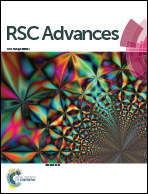GlmU inhibitor from the roots of Euphorbia ebracteolata as an anti-tuberculosis agent†
Abstract
At present, the emerging drug-resistance of Mycobacterium tuberculosis (M. tb) against existing frontline drugs has prompted the development of novel anti-tuberculosis agents based on new targets. Activity of the bifunctional enzyme, glucosamine-1-phosphate acetyltransferase activity and N-acetylglucosamine-1-phosphate uridyltransferase (GlmU) is essential for biosynthesis of the mycobacterium cell wall components and has been proposed as a potential drug target for therapeutic interventions. On the basis of the high-throughput screening of the GlmU AT inhibitor, an extract of Euphorbia ehracteolata displayed a significant inhibitory effect among 49 tested herbal medicines. Using the bioassay-guided separation, an aromatic diterpenoid ebractenoid F was identified as a GlmU AT inhibitor (IC50: 4.608 μg mL−1). Inhibition kinetics showed that ebractenoid F acted as a competitive inhibitor for substrate acetyl-CoA and an uncompetitive inhibitor for substrate GlcN-1-P. Ala434 was deduced to be the key active residue for the interaction between ebractenoid F and GlmU. Furthermore, ebractenoid F displayed an anti-mycobacterial effect against M. tb H37Ra with a minimal inhibitory concentration (MIC) of 12.5 μg mL−1 along with an inhibitory effect on the formation of biofilm and a synergistic effect with isoniazid against M. tb H37Ra. Above all, a GlmU inhibitor was identified from E. ehracteolata and is proposed to be a potential therapeutic anti-tumberculosis agent.



 Please wait while we load your content...
Please wait while we load your content...